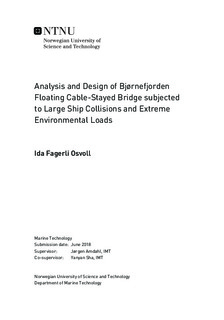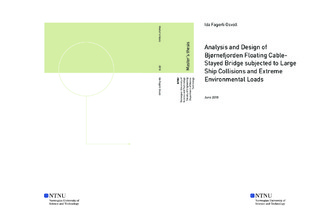| dc.description.abstract | The objective of this master thesis is to study the global behaviour of the end-anchored floating bridge across the Bjørnafjord when it is subjected to high energy ship collision and extreme environmental loads. The end-anchored floating bridge is one of the proposed concepts for the crossing of the Bjørnafjord, which is a part of of a national project, where the aim is to replace ferries with bridges and undersea tunnels. The end-anchored bridge is curved in the horizontal plane, and has a total length of 5.5 km. The bridge is supported by 46 steel pontoons, which are placed with a spacing of 100 m between each. At the south end of the bridge, the bridge girder is elevated in order to serve as a transit channel for ship traffic. This is the cable-stayed section, where the bridge girder is supported by a 230 m tall tower. According to the Norwegian Public Road Administration (NPRA), the crossing of the Bjørnafjord will be the longest floating bridge in the world, and existing design regulations are therefore not applicable. Scenario-based analyses are therefore required in order to predict governing physical processes and to assess the capacity of the bridge to withstand them.
The scope of work for this thesis is structural analysis of global bridge response in the ultimate and accidental limit state. The analyses of the bridge are carried out in USFOS, a computer program for nonlinear structural analysis. During the project thesis, which served as preparatory work for the master thesis, a model of the end-anchored floating bridge was created in USFOS. During the master thesis, the model has been developed further, in order to better represent the hydrodynamic properties of the pontoons. This involves modelling of added mass and drag properties, as well as including rotational waterplane stiffness. An eigenvalue analysis is carried out, and it is found that the fundamental eigenperiod of the bridge is 119.6 s, and that the vertical modes in the floating low bridge have periods close to 6 s. The results of the eigenvalue analysis coincide well with results obtained in alternative software.
Ship impact is modelled by applying a mass with an initial velocity, connected to the bridge through a nonlinear spring. The spring represents the combined force-deformation curve for the ship and bridge. The design collision energies determined by the NPRA are in the range of 250 to 660 MJ. In addition to the design energies, a 1000 MJ collision is studied. Both collisions with pontoons and with the bridge girder are considered. In collisions where the ship strikes the bridge perpendicularly to its longitudinal axis, the impact force is balanced by bending moments in the bridge girder. The maximum bending moment is reached at the collision site, but due to interference between propagating and reflected bending waves, high bending moments can also be reached at the end-supports of the bridge. In the case of a 660 MJ collision with the pontoon closest to the transit channel, the bending moment in the bridge exceeds the capacity, both at the impact site and at the end-supports. When considering lower energy collisions further from the transit channel, the bridge seems to have sufficient strength to survive. However, in collisions between a ship deckhouse and the bridge girder, the bending moment at the collision site is close to the capacity of the undamaged girder. Since local deformations will reduce the capacity of the girder,
more thorough analyses are required in order to assess if the bridge can survive these impacts.
The response of the bridge in a 100-year storm is also considered in this thesis. Stochastic wind speed as a function of time is generated in WindSim, while wave loads are calculated in MATLAB and applied as nodal loads. The results indicate that there is an issue with numerical drift in the wave analyses, and it is therefore decided to focus on wind loads. Wind is applied both statically and dynamically. It is found that wind loads are mainly carried by bending moments in the bridge girder. When dynamic effects are accounted for, about one third of the bending capacity is utilized. If wave loads, self-weight and ULS safety factors are also taken into account, the utilization of the girder will be high at the end-supports. | |

